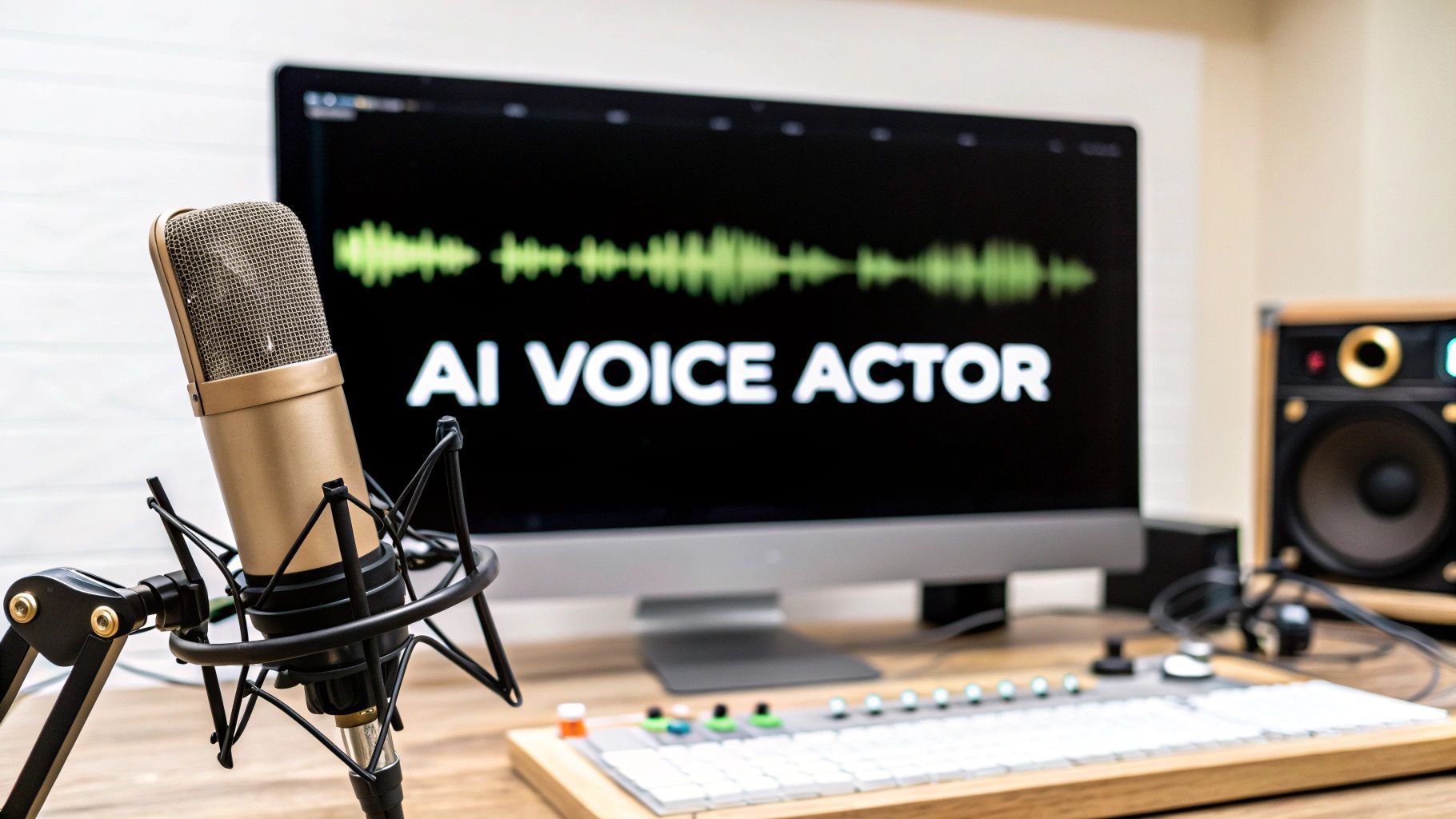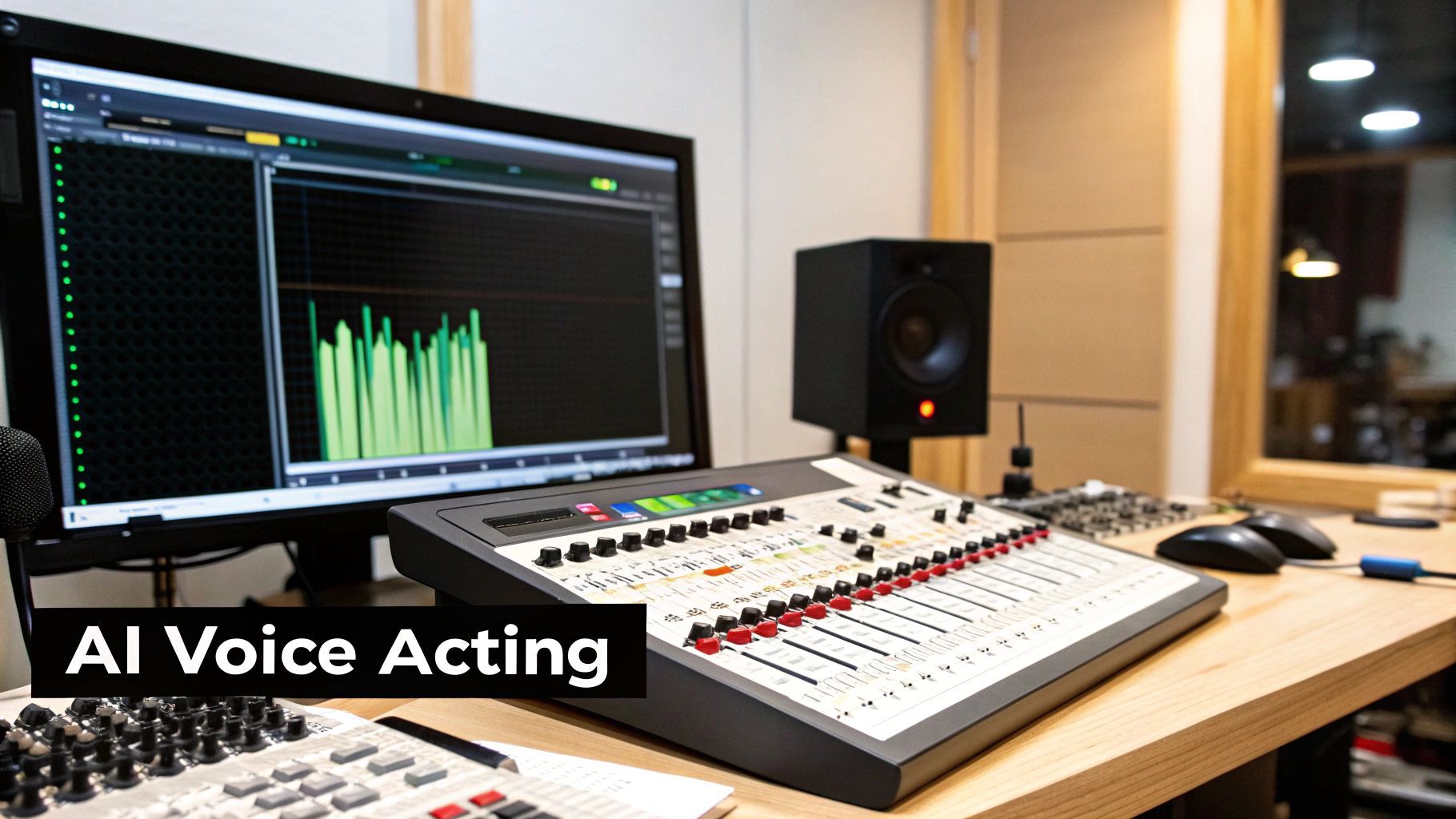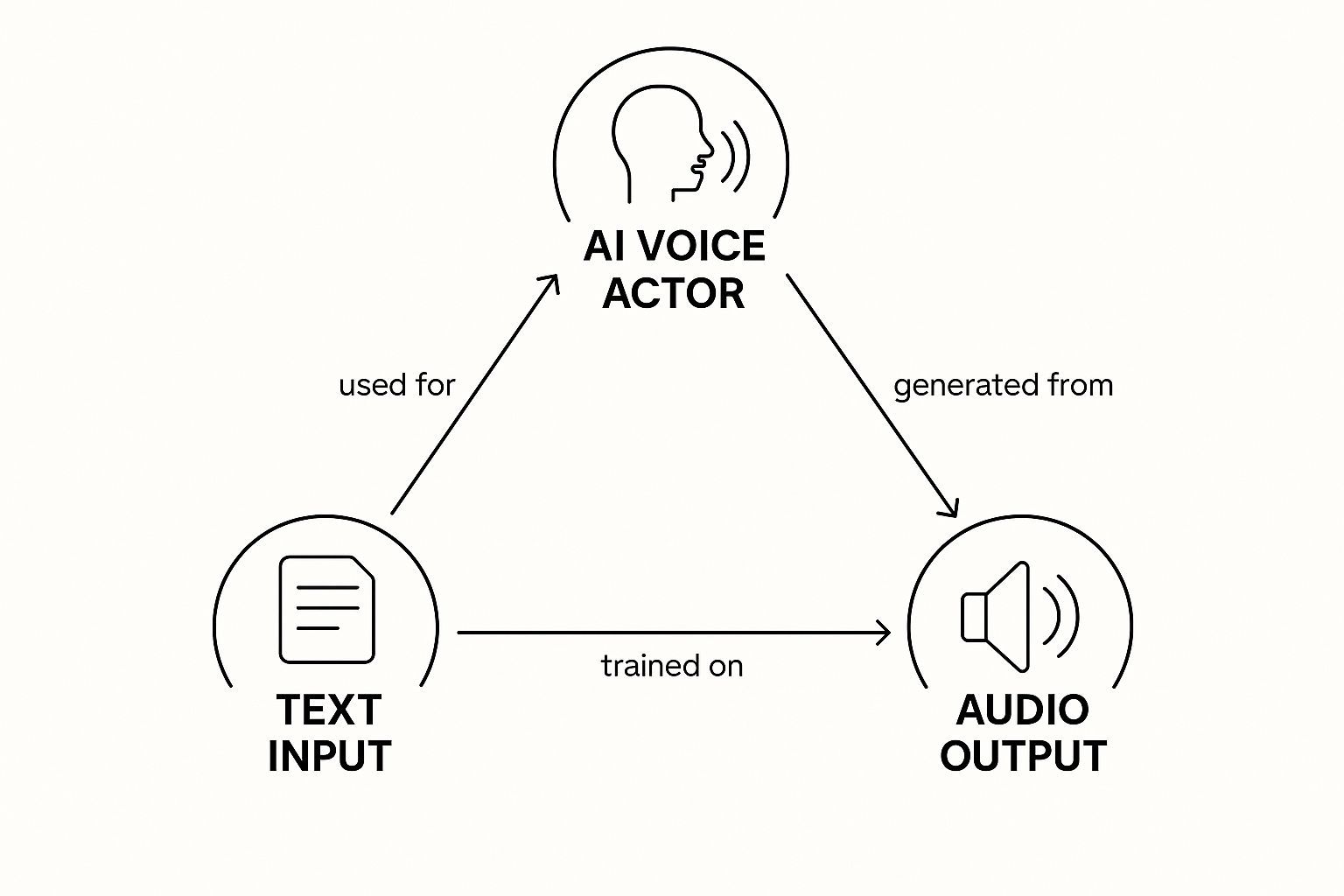Your Guide to AI Tools for Content Creation




Discover how a modern AI voice actor can transform your content. This guide covers how the tech works, key benefits, and how to choose the perfect AI voice.
Ever heard of an AI voice actor? It’s not about those clunky, robotic voices from old GPS systems. We’re talking about sophisticated software that uses artificial intelligence to turn text into speech that sounds astonishingly human—complete with all the emotion, tone, and personality you'd expect from a pro.
These aren't just text-to-speech tools; they're becoming genuine digital performers for content creators everywhere.

Picture this: you have a world-class voice actor on call, 24/7. They're ready to nail the perfect read for any project you throw at them, instantly. That’s not science fiction anymore—it's the reality of working with a modern AI voice actor. This tech has rocketed from a fun gimmick to a must-have tool for creators.
Think of it less like a machine reading words off a page and more like a digital chameleon. This performer can shift its tone, style, and emotion to match whatever you need. Need an energetic voice for your YouTube intro? Done. A professional and crystal-clear narrator for an e-learning course? You got it. A warm, friendly host for your next podcast? No problem.
For a quick snapshot, here’s a look at what AI voice actors bring to the table and where they shine the brightest.
Key Benefit Primary Use Case Example Speed & Scalability Producing voiceovers for a 20-part video series in a single afternoon. Cost-Effectiveness Creating professional narration for an indie game without a studio budget. Consistency Ensuring the same brand voice across all social media video ads. Creative Flexibility Testing five different voice styles for a podcast intro before committing.
This table just scratches the surface, but it gives you a solid idea of the immediate advantages.
The thirst for high-quality audio has sent this field into overdrive. The market for AI voice generators isn't just growing; it's absolutely exploding.
Back in 2023, the global AI voice generator market was already valued at around $3.5 billion. But hang on tight—experts predict it could skyrocket to $40.25 billion by 2032. That’s not just growth; it’s a seismic shift in how we create audio content.
What’s fueling this fire? Creators like you, who need to churn out more fantastic content faster than ever. This incredible trend sends a clear message: AI voices are becoming a standard part of the modern creator's toolkit. If you're curious about the numbers, you can dive into the full research on the AI voice generators market.
So, what’s in it for you? An AI voice actor can open up creative avenues that used to be blocked by tight budgets, tricky casting, and endless recording sessions.
Now, you can:
Create Content at Scale: Got a script? You can have hours of polished voiceovers ready to go in minutes. Experiment Without Risk: Try out different voices, moods, and deliveries for your projects. No extra cost, no extra hassle. Keep It Consistent: Lock in a single, recognizable voice for an entire video series, a suite of tutorials, or a whole season of your podcast.
Consider this your backstage pass. We’re about to dive into how this technology works, the real-world benefits, and how you can start directing your very own digital performer. Get ready to go from just watching this trend to confidently using an AI voice actor to bring your projects to life.
Ever wondered how an AI voice actor goes from sounding like a '90s GPS to a genuinely convincing performer? It's not magic, but it's pretty close. Think of it less like a computer reading and more like a human actor poring over a script, practicing their lines, and learning to hit every emotional beat.
The technology behind this is called Text-to-Speech (TTS), but this isn't the clunky TTS you might remember. Today's systems have evolved far beyond just matching letters to sounds. They use sophisticated algorithms to understand context, sentence structure, and even emotional cues. This lets the AI produce speech that actually flows, with the kind of pacing and intonation you'd expect from a person. You can get a feel for the basics by checking out modern text-to-speech tools and seeing how they work.
But the real secret ingredient? Neural networks. These are powerful computer systems designed to loosely mimic the way our own brains work.
Neural networks are the digital "mind" behind the AI voice. You train them by feeding them an absolutely massive diet of audio—we're talking thousands of hours of recordings from real human voice actors, all paired with the original text.
By sifting through this mountain of data, the network starts to connect the dots between written words and the actual sounds of human speech. It learns to recognize all the subtle patterns that make us sound human:
Pitch: The natural rise and fall of the voice, like when you’re asking a question. Pacing: The speed of talking, which can convey anything from high-energy excitement to thoughtful hesitation. Pauses: Those strategic silences that give certain phrases weight and impact. Inflection: The tiny stresses on specific words that signal emotion.
This image breaks down the basic idea, showing how a simple text script gets transformed into nuanced, lifelike audio.

As you can see, it's a journey from script to performance, all driven by intensive model training. The AI isn't just "reading"—it's interpreting the text and generating a vocal performance from scratch based on its deep understanding of how we talk.
This whole training process is like a digital apprenticeship. At first, the AI’s attempts at speech are pretty clumsy and unnatural. But with every round of training, it refines its approach and gets better and better, just like an actor honing their craft through endless rehearsals.
The real goal is to get the AI to move past simple pronunciation and achieve what you might call "vocal intelligence." It's not just about saying the words right; it's about saying them with the right feeling—whether that’s joy, sadness, urgency, or authority. That’s what makes it a true AI voice actor, not just a text-reader.
This deep learning is what allows the AI to tackle any new script you throw at it and generate completely original speech, rather than just cutting and pasting old soundbites. If you want to dive deeper into how this works on a technical level, you can explore the role of neural networks and how they mimic brain functions.
The best platforms now take this a step further, giving you—the creator—the director's chair. You can fine-tune the AI's performance with simple controls to get the exact emotional output you need.
For instance, you can tell the AI to:
Speak with a higher pitch and faster pace for an energetic, excited vibe. Lower its tone and slow down to create a more serious or somber mood. Add specific pauses before key words for a touch of dramatic flair.
This level of control turns the AI from a simple tool into a genuine creative partner. The end result is a performance that doesn’t just relay information but actually connects with your audience, bringing your scripts to life with real, human nuance.

Let's be honest, using an AI voice actor isn't just about saving a few bucks. It's about creative empowerment. Think of it as the master key that opens doors to projects once barricaded by tight budgets, impossible timelines, and logistical nightmares.
It’s your ticket to finally breaking through those old creative barriers. This tech lets you bring your most ambitious audio projects to life without the traditional hurdles. Suddenly, those ideas that felt too big, too complex, or too expensive are completely within your grasp.
This newfound freedom is a massive advantage for creators of all stripes, from solo YouTubers to massive marketing teams.
Imagine you need to produce a 50-part training series. In the past, this meant weeks of scheduling a human actor, booking studio time, and slogging through edits. With an AI voice actor? That's a task you can knock out in an afternoon. Seriously.
This instant scalability is where the magic really happens. You can turn thousands of words into pristine audio in minutes, not days. This means you can churn out more content, get it in front of your audience faster, and stay ridiculously ahead of your content calendar without breaking a sweat.
The real superpower here is decoupling production from time. An AI voice doesn't get tired, never needs a coffee break, and can process a mountain of scripts all at once. It unlocks a level of output that was pure fantasy for most creative teams until now.
This is how an indie game developer can suddenly voice hundreds of unique characters or an e-learning platform can launch courses in multiple languages almost overnight. The scale is practically infinite.
Consistency is the secret sauce for any strong brand. For any project that spans multiple episodes—like an audiobook series, a podcast, or a huge library of training videos—keeping that same vocal identity is absolutely critical.
We’re all human. A voice actor's voice can subtly change day-to-day based on their health, mood, or even the room they’re recording in. An AI voice actor completely eliminates that variable.
The voice you pick on day one will sound exactly the same on day one hundred. This guarantees a seamless experience for your listeners across every piece of content, reinforcing your brand and building trust. No more jarring vocal shifts between videos recorded months apart.
For a wider perspective on how artificial intelligence is changing the game, you can explore some of the leading AI content creation tools that provide similar boosts to your workflow.
What if you had an entire casting agency on standby, ready to audition for you at a moment's notice? That’s the fun part of using a modern AI voice platform. You don't just get one voice; you get a whole library of them.
This opens up a creative playground for experimentation:
Quick Prototypes: Wondering if your ad script hits harder with a British accent or an American one? Or maybe a female voice instead of a male one? Generate both in seconds and let the results speak for themselves. Diverse Characters: Producing an audio drama or an animated short? You can cast an entire lineup—an old wizard, a bubbly hero, a sarcastic robot sidekick—all from the same dashboard, without a single casting call. Global Reach: Many platforms come loaded with voices in dozens of languages and accents. This lets you effortlessly adapt your content for international markets, breaking down language barriers to grow your audience.
The freedom to iterate and experiment without penalty is a huge creative win. You can A/B test voiceovers for marketing campaigns to see which one actually converts better or try out different narrative tones for your documentary before locking anything in.
Ultimately, an AI voice actor removes the friction from the creative process. It hands you the tools to not only execute your vision with incredible speed and precision but also to explore wild new ideas that were simply impossible before. It’s all about making bigger, bolder, and better content—faster than ever.
All the tech specs and theory are great, but the real question is: how does an AI voice actor actually hold up in the wild? It's time to move from abstract concepts to concrete examples and see how real creators are using this tech to solve everyday problems and bring their visions to life.
These aren't just hypotheticals. These are real stories happening right now, across totally different fields. We're going to follow three creators who each hit a wall with a unique challenge and found their solution with an AI performer. Their journeys will show you exactly how this tool can slot into your own work.
These stories prove that an AI voice actor is so much more than a cool gimmick. It's a practical, powerful tool for getting things done.
First up, meet Alex. He’s a history buff who pours his heart into a YouTube channel creating deep-dive mini-documentaries. His scripts are flawless, his visuals are slick, but his narration was always the weak link. Shelling out for a professional voice actor for every single weekly video? Not a chance on his shoestring budget.
For months, Alex bit the bullet and recorded the voiceovers himself. He was passionate, sure, but he knew his delivery just didn't have that polished, authoritative gravitas his epic topics deserved. The content was stellar, but the audio was holding it back.
Then he stumbled upon AI voices. Suddenly, instead of spending hours in a stuffy room recording and re-recording, he could just drop his finished script into a platform and get a perfect narration back in minutes. He found an AI voice actor with a deep, resonant tone that sounded like a seasoned documentary pro. The result? His channel's production quality shot through the roof, practically overnight. Viewers even started commenting on the "new narrator," praising the professional sound. Alex could finally focus 100% on his research and storytelling, confident the final audio would always be world-class.
Next, let's talk about Maria, an instructional designer at a mid-sized tech company. Her team got a huge project: create a comprehensive training program for their new software, which was launching in five different countries. The challenge was daunting. How could they possibly produce high-quality, consistent training modules in multiple languages without a budget the size of a Hollywood blockbuster?
Their first thought was to hire human voice actors for each language. The logistical nightmare became obvious almost immediately—juggling five different actors, studios, and schedules was a full-time job in itself.
This is where an AI voice actor became their secret weapon. Maria found a single platform that offered incredible voices across all their target languages.
Consistency: The tone and pacing were perfectly synced across the English, Spanish, German, French, and Japanese versions. It was seamless. Speed: When a last-minute software update forced a script change, she regenerated the audio for all five languages in less than an hour. Try doing that with human actors! Cost Savings: The total cost was just a tiny fraction of what it would have taken to hire five separate voice professionals.
Maria’s team rolled out a polished, multilingual training suite on time and way under budget. Every user, no matter where they were, got the exact same high-quality learning experience. To take it even further, you can pair AI voices with a powerful AI video generator and produce the entire training module from a single script.
Finally, let's look at Ben. Ben is a creative writer who had this amazing dream of producing a multi-character sci-fi audio drama for his podcast. His story involved a stoic starship captain, a quippy android, and a gruff alien mercenary. But casting, directing, and recording three separate actors was a mountain he just couldn't climb as a solo creator.
His ambitious project sat on his hard drive for years, just a collection of scripts. The idea of coordinating a cast, even for a passion project, felt overwhelming and prevented him from ever starting.
Feeling a spark of inspiration from new technology, Ben decided to try "casting" his audio drama with AI voices. He spent a fun afternoon browsing a library of digital performers, hand-picking the perfect voice for each of his characters. He gave the captain a firm, commanding voice; the android a crisp, perfectly articulated cadence; and the alien a deep, gravelly tone.
By tweaking the pitch and speed for each line, he could "direct" their performances to add genuine emotion and drama. His script leaped off the page and came alive. He was producing entire episodes right from his desk, acting as the writer, director, and producer without a single casting call. His dream project was finally a reality, all thanks to the creative freedom his new AI cast gave him.

So, you're ready to hire your first digital performer? Fantastic. Let me tell you, picking the right AI voice actor isn't like scrolling through a font menu. It’s a casting call. You’re not just picking a sound; you're choosing a personality that will become the voice of your brand and hopefully, a friendly face (or voice) to your audience.
The real aim here is to find a voice that doesn't just read words off a page but actually performs your script, bringing it to life. Think of this as your framework for finding an AI voice actor that clicks, ensuring your message lands perfectly every single time. Let's walk through how to make the right choice without getting lost in the options.
Before you listen to a single voice sample, stop and think like a director. What's the soul of this project? What emotion are you trying to bottle? A voice that kills it for a high-octane workout video will probably sound completely out of place in a serious corporate training module. It just makes sense.
Start by asking yourself a few simple questions:
What's the goal? Are you here to teach, entertain, persuade, or maybe just offer a bit of comfort? What's the vibe? Do you need a voice that sounds authoritative and trustworthy, or more like a friendly, approachable pal? What’s your brand's style? Is your brand modern and a little edgy, or more on the traditional and reliable side?
Scribbling down a few keywords like "energetic," "calm," "professional," or "playful" creates a creative compass. This simple first step will guide every other decision you make and keep the whole process focused and effective.
Okay, you’ve got your project's personality locked down. Now, who’s listening? The right voice can forge an instant bond with your target audience. Things like perceived age, gender, and even accent play a huge part in how your message is received.
For example, a younger, more dynamic voice might be just the ticket for a TikTok ad. On the other hand, a mature, measured voice could be the perfect fit for a financial services explainer video. Accents are also a seriously powerful tool for localization, helping you connect with specific regional markets and making your content feel more authentic and familiar. If you want to dive deeper, our guide on personalized voice messages explores how this kind of tailoring can build much stronger connections.
Just like you'd give direction to a human actor, digital voices also benefit from a little guidance. Using advanced LLM prompt engineering techniques can help you fine-tune the performance to get the exact tone and delivery you're after.
With your creative brief in hand, you’re finally ready to start auditioning some talent on different AI voice platforms. Here’s the deal: not all services are created equal. They vary wildly in quality, features, and how they charge. Let’s break down the common models so you can see what’s out there.
Finding the right service depends on your project's scale and frequency. This table breaks down the common models to help you choose the best fit for your needs and budget.
Platform Model Best For Common Features Pricing Structure Subscription Services Frequent creators, businesses with ongoing needs. Large voice libraries, advanced editing controls, API access. Monthly or annual fee. Pay-As-You-Go One-off projects or infrequent users. Simple interface, character-based generation. Per-character or per-project fee. Custom Cloning Brands seeking a unique, exclusive audio identity. Creation of a proprietary voice model. High upfront cost, often enterprise-level.
As you test drive these platforms, really listen for the naturalness of the speech. Are there weird pauses? Awkward pronunciations? The best AI voice actor will sound fluid and human, not like a GPS giving directions.
Most of the top-tier platforms offer free trials, so use them! Don't just test a generic phrase. Upload a short paragraph from one of your actual scripts to see how different voices handle your specific content. This hands-on approach is the absolute best way to "audition" your digital performers and find the one that truly fits your vision.
Diving into the world of AI voices can feel a bit like stepping into the future, and it's totally normal to have a few questions buzzing around. The technology is moving at a breakneck pace, so getting the lay of the land before you jump in is just plain smart. Let's tackle some of the biggest questions creators like you are asking.
Think of this as your personal FAQ—no jargon, just straight answers to give you the confidence to start creating. From whether an AI can sound genuinely sad to the thorny ethical questions, we’ll cover the final details you need to move forward.
This is the big one, isn't it? The short answer is a resounding yes. Forget the flat, monotone robot voice from old sci-fi movies. Today's AI voices are a whole different beast. They're trained on colossal datasets of human speech, allowing them to soak up and replicate all the tiny, nuanced details that signal real emotion.
It’s about more than just reading words; it's about delivering a performance. The best platforms hand you the director's chair, giving you control over:
Pitch and Inflection: You can tweak the rise and fall of the voice to convey excitement, seriousness, or a touch of sarcasm. Pacing and Speed: Want to create urgency? Speed it up. Need to add some dramatic weight? Slow it down. Emphasis and Pauses: You can literally tell the AI which words to hit harder or where to insert a strategic pause to let an idea sink in.
You're not just pressing "play." You're guiding the AI voice actor to craft a performance that feels authentic and connects with your audience on an emotional level. This control is what elevates it from a simple text-reader to a genuine digital performer.
This is a massively important question, and the answer hinges entirely on where you get your AI voice. The good news is that reputable companies are built on solid ethical and legal ground. They either create completely synthetic voices from the ground up or, more commonly, they partner with human voice actors. In those cases, the actors are paid fairly and give their explicit consent for their voice to be used to train an AI model.
When you use a trusted service, you’re basically licensing a voice that’s been sourced ethically and is legally cleared for you to use. It’s a win-win that protects you, your project, and the original voice actor.
On the flip side, there's a dark side to this tech: unauthorized voice cloning. This is straight-up theft of someone's voice without their permission, and it's both an ethical nightmare and legally dangerous. As one creator found out when a company allegedly ripped off his voice for their ads, "You can't just steal someone's voice or likeness, and slap it on your products or videos."
The takeaway? Stick with providers who are transparent about how they source and create their voices. It’s the only way to ensure your work is built on a foundation of integrity.
I get it—the last thing you want is for your brand to sound like everyone else. But the idea that all AI voices are identical is a relic from the early, clunky days of the technology. Today, the diversity is just staggering.
The top platforms have massive libraries packed with hundreds of distinct voices. You can browse through different genders, ages, accents (from a Texas drawl to a crisp British accent), and styles to find the perfect one that captures your brand's unique personality. It’s like having a Hollywood casting call at your fingertips.
And for brands that crave something truly one-of-a-kind? Many services now offer custom voice cloning. This lets you create a proprietary AI voice actor that is 100% unique to you. It becomes an audio asset you own, guaranteeing a consistent and instantly recognizable sound across all your content. That’s how you stand out from the crowd.
Honestly, you'll probably be shocked at how easy it is. You don’t need an audio engineering degree or any kind of technical wizardry. Modern AI voice platforms are designed to be incredibly intuitive, putting professional-level results within anyone's reach.
The whole process usually boils down to three simple steps:
Enter Your Script: Just type or paste your text into the editor. Choose Your Voice: Audition a few "actors" from the library and pick the one that fits your project. Generate and Refine: Click a button, and poof—you have audio. From there, you can make tiny adjustments to the speed or pitch to nail the delivery.
That’s really it. These platforms are built for everyone, from solo creators tinkering on a passion project to full-scale marketing teams on a deadline. Just as artists are now using AI to compose music, you can use these tools to create amazing audio. In fact, if music creation is your thing, you should check out our guide on how to make music with AI.
Ready to bring your own creative ideas to life with a unique voice? At SendFame, we make it easy to generate bespoke videos, messages, and music with AI. Instantly create compelling content with a distinct personality. Check out SendFame and start creating today!
Create Epic
SendFame